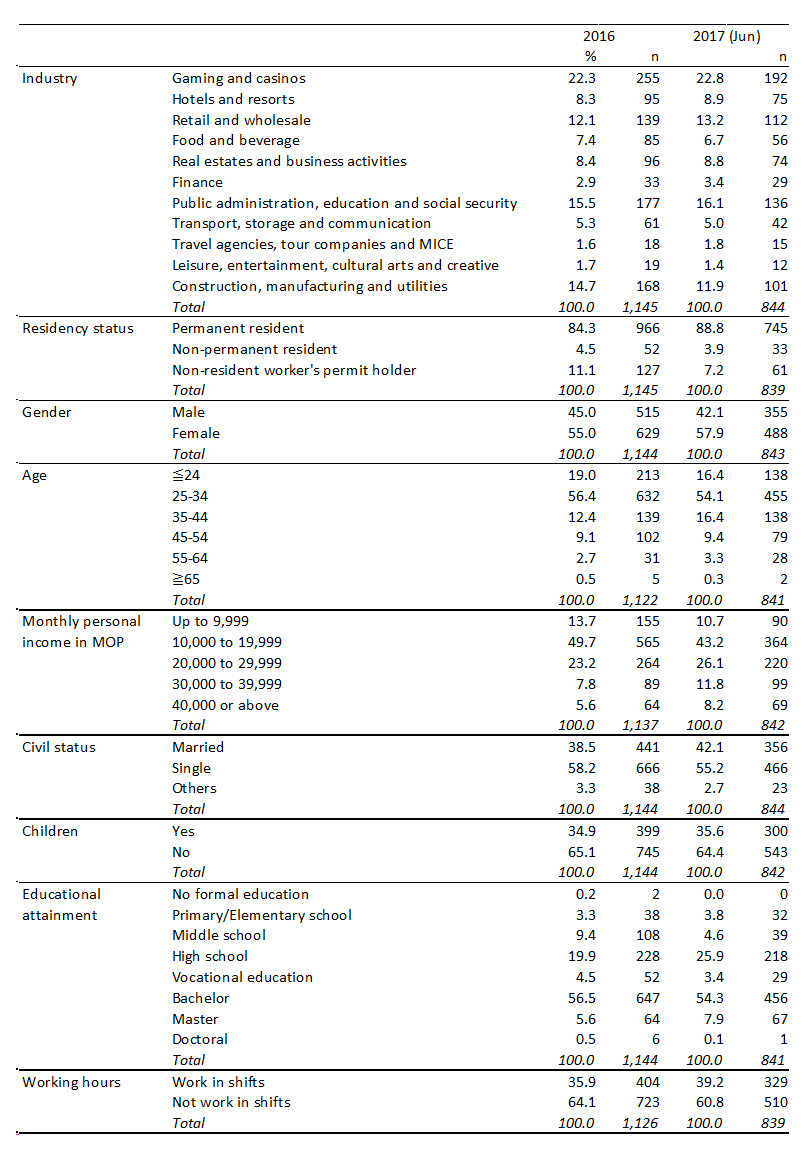Data collection
Data is collected via field survey twice a year, in June and December. Interviews take place in major transportation hubs in Macao as well as several residential areas. Respondents are selected following a systematic random sampling technique and interviews are conducted face-to-face with the help of a structured questionnaire. Interviews are conducted in either English or Chinese. Respondents are interviewed if they are permanent, non-permanent residents, or hold non-resident worker’s permit, and are employed full-time in Macao at the time of the survey. The targeted sample size every year is 1,050.
From December 2016 cohort onwards until December 2018, MHRM online data collection has been launched in parallel with field data collection to further expand the scope of targeted samples and to obtain a more holistic view based on the employment population.
Definition, source, and measurement of key variables monitored
The following four variables are monitored yearly (since 2012). Other variables are added as needs and trends dictate, and are subject to feedback from colleagues in industry, academia, and policymakers.
Perceived fairness of compensation and benefits is measured using a two-item scale developed by Mount & Bartlett (2002). The two items are: “Compared to similar companies in my industry, I am paid fairly for the work I do,” and “Compared to similar companies in my industry, the benefits I receive at my company are fair.”
Job satisfaction is measured using the JDS scale (Hackman & Oldham, 1974) and is composed of the average of three survey items: “Generally speaking, I am very satisfied with my current job”, “I am generally satisfied with the kind of work I do in my current job”, and “I frequently think of quitting my current job” (reverse coded).
Work stress is measured using the job stress scale (JSS) developed by Lambert, Hogan, Camp & Ventura (2006) and is assessed as the average of respondents’ level of agreement with four survey items: “A lot of time my job makes me very frustrated or angry”, “I am usually under a lot of pressure when I am at work”, “When I’m at work I often feel tense or uptight”, “I am usually calm and at ease when I am working” (reverse coded), and “There are a lot of aspects of my job that make me upset.”
Intent-to-stay (ISS) is measured using a scale developed by Hunt, Osborn & Martin (1981) and is assessed as the average level of agreement with four survey items: “I will definitely leave this organization in the next year”, “It is very unlikely that I would ever consider leaving this company”, “If I were completely free to choose, I would prefer very much not to continue working for this organization”, and “It is very important for me to spend my career in this organization.” ISS can be considered a proxy for employee loyalty (though it has other dimensions as well) and may be able to predict short- to medium-term turnover levels at organizations.
Response scale
Respondents’ level of agreement is captured using a 5-point Likert scale with 5 indicating strong agreement and 1 indicating strong disagreement. The higher the score, the higher level is the job satisfaction, perceived fairness of compensation and benefits, intention to stay and job stress. All scales reported in the charts correspond to this 5-point agreement scale, unless otherwise indicated.
Survey respondents characteristics
Demographic and job characteristics of survey respondents for data collected in 2012-2021 are reported in Table 1 below. All analyses in the regular MHRM general report are weight-adjusted by industry based on the relative distribution of the working population in Macao reported by the Statistics and Census Service of Macao SAR government.


